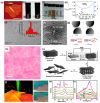Properties, Preparation and Applications of Low Dimensional Transition Metal Dichalcogenides
- PMID: 29949877
- PMCID: PMC6071048
- DOI: 10.3390/nano8070463
Properties, Preparation and Applications of Low Dimensional Transition Metal Dichalcogenides
Abstract
Low-dimensional layered transition metal dichalcogenides (TMDs) have recently emerged as an important fundamental research material because of their unique structural, physical and chemical properties. These novel properties make these TMDs a suitable candidate in numerous potential applications. In this review, we briefly summarize the properties of low-dimensional TMDs, and then focus on the various methods used in their preparation. The use of TMDs in electronic devices, optoelectronic devices, electrocatalysts, biosystems, and hydrogen storage is also explored. The cutting-edge future development probabilities of these materials and numerous research challenges are also outlined in this review.
Keywords: chemical vapor deposition; crystal structure; electronic structure; low dimensional transition metal dichalcogenides; preparation methods.
Conflict of interest statement
The authors declare no conflicts of interest.
Figures










Similar articles
-
Transition metal dichalcogenides and beyond: synthesis, properties, and applications of single- and few-layer nanosheets.Acc Chem Res. 2015 Jan 20;48(1):56-64. doi: 10.1021/ar5002846. Epub 2014 Dec 9. Acc Chem Res. 2015. PMID: 25490673
-
Atomic and structural modifications of two-dimensional transition metal dichalcogenides for various advanced applications.Chem Sci. 2022 May 18;13(26):7707-7738. doi: 10.1039/d2sc01398c. eCollection 2022 Jul 6. Chem Sci. 2022. PMID: 35865881 Free PMC article. Review.
-
Recent Progress in CVD Growth of 2D Transition Metal Dichalcogenides and Related Heterostructures.Adv Mater. 2019 Oct;31(41):e1901694. doi: 10.1002/adma.201901694. Epub 2019 Aug 12. Adv Mater. 2019. PMID: 31402526 Review.
-
Advances in Two-Dimensional Magnetic Semiconductors via Substitutional Doping of Transition Metal Dichalcogenides.Materials (Basel). 2023 May 12;16(10):3701. doi: 10.3390/ma16103701. Materials (Basel). 2023. PMID: 37241328 Free PMC article.
-
Optical Enhancement of Indirect Bandgap 2D Transition Metal Dichalcogenides for Multi-Functional Optoelectronic Sensors.Adv Mater. 2023 Nov;35(46):e2303272. doi: 10.1002/adma.202303272. Epub 2023 Sep 29. Adv Mater. 2023. PMID: 37453927 Review.
Cited by
-
Indium Tin Oxide Nanowire Arrays as a Saturable Absorber for Mid-Infrared Er:Ca0.8Sr0.2F2 Laser.Nanomaterials (Basel). 2022 Jan 28;12(3):454. doi: 10.3390/nano12030454. Nanomaterials (Basel). 2022. PMID: 35159801 Free PMC article.
-
Geometric control of diffusing elements on InAs semiconductor surfaces via metal contacts.Nat Commun. 2023 Jul 27;14(1):4541. doi: 10.1038/s41467-023-40157-5. Nat Commun. 2023. PMID: 37500640 Free PMC article.
-
Pulsed Laser Deposition of Nanostructured MoS3/np-Mo//WO3-y Hybrid Catalyst for Enhanced (Photo) Electrochemical Hydrogen Evolution.Nanomaterials (Basel). 2019 Sep 30;9(10):1395. doi: 10.3390/nano9101395. Nanomaterials (Basel). 2019. PMID: 31574968 Free PMC article.
-
Enhancing the stretchability of two-dimensional materials through kirigami: a molecular dynamics study on tungsten disulfide.RSC Adv. 2024 Aug 5;14(34):24483-24491. doi: 10.1039/d4ra04814h. eCollection 2024 Aug 5. RSC Adv. 2024. PMID: 39108951 Free PMC article.
-
One-dimensional facile growth of MAPbI3 perovskite micro-rods.RSC Adv. 2019 Apr 12;9(20):11589-11594. doi: 10.1039/c9ra00200f. eCollection 2019 Apr 9. RSC Adv. 2019. PMID: 35520240 Free PMC article.
References
Publication types
LinkOut - more resources
Full Text Sources
Other Literature Sources

